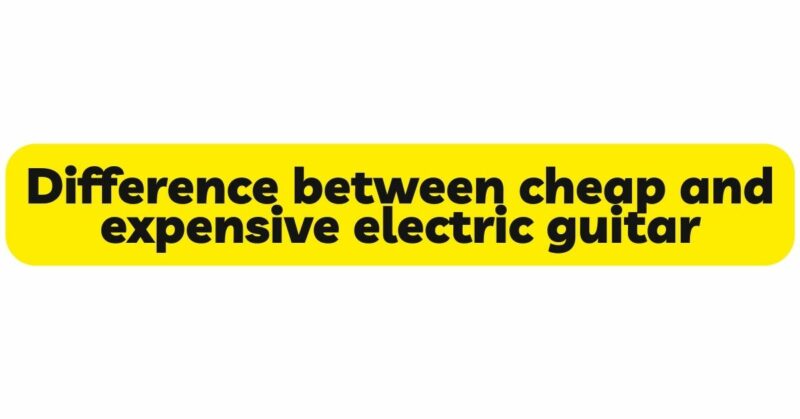When it comes to electric guitars, there is a wide range of options available, ranging from affordable entry-level instruments to high-end, premium models. Many aspiring guitarists find themselves wondering about the differences between cheap and expensive electric guitars. Is the price difference justified? In this article, we will delve into the various aspects that differentiate cheap and expensive electric guitars. By exploring factors such as materials, craftsmanship, components, playability, and sound quality, we aim to shed light on the contrasting characteristics and benefits of each category.
- Build Quality and Craftsmanship: One of the most noticeable differences between cheap and expensive electric guitars lies in their build quality and craftsmanship. Expensive guitars often feature meticulous attention to detail, precise joinery, and higher-quality materials. Skilled luthiers carefully craft expensive guitars, ensuring optimal resonance, stability, and overall durability. In contrast, cheaper guitars may exhibit less refined craftsmanship and use lower-quality components, resulting in potential compromises in terms of construction, finishing, and overall playability.
- Choice of Tonewoods: The tonewoods used in electric guitars significantly impact their sound and playability. Expensive guitars tend to feature high-quality tonewoods, such as mahogany, maple, rosewood, and exotic woods like koa or ebony. These tonewoods contribute to the guitar’s resonance, sustain, and tonal complexity. In contrast, cheaper guitars may utilize less expensive tonewoods or alternative materials, which can affect the instrument’s overall sonic character and timbre.
- Electronics and Pickups: Another critical factor that distinguishes cheap and expensive electric guitars is the quality of their electronics and pickups. Expensive guitars often come equipped with high-end pickups from reputable manufacturers, offering superior clarity, tonal versatility, and dynamic range. These pickups capture the nuances of the guitar’s sound and allow for a broader range of tonal options. In contrast, cheaper guitars may have generic or lower-quality pickups, which may limit the player’s ability to achieve desired tones and may produce less defined and articulate sound.
- Hardware and Components: The hardware and components used in electric guitars contribute to their overall performance and durability. Expensive guitars typically feature top-of-the-line hardware, such as high-quality tuning machines, bridges, and nuts. These components offer enhanced tuning stability, improved intonation, and smoother operation. Cheaper guitars may feature generic or lower-grade hardware, which may be prone to issues like tuning instability or premature wear and tear. However, it’s important to note that even budget guitars can have reliable hardware that performs adequately for beginners or players on a tight budget.
- Playability and Setup: Playability is a crucial consideration when comparing cheap and expensive electric guitars. Higher-priced guitars often receive more meticulous setup attention, ensuring comfortable string action, optimal string-to-fret contact, and smooth fretwork. This results in an instrument that is easier to play and provides a more enjoyable experience. Cheaper guitars may require additional setup or adjustment to achieve similar levels of playability. However, with proper setup and adjustments, even budget guitars can offer decent playability and responsiveness.
- Aesthetics and Finishing: Expensive electric guitars often boast visually stunning aesthetics and meticulous finishing. They may feature intricate inlays, luxurious binding, unique finishes, and attention-grabbing design elements. The attention to detail in the aesthetic aspects of expensive guitars can contribute to their overall appeal. Cheaper guitars, on the other hand, may have simpler designs and more basic finishes. While aesthetics do not directly impact sound or playability, they can add to the overall appeal and pride of ownership.
- Resale Value and Prestige: Another factor to consider when comparing cheap and expensive electric guitars is their resale value and prestige. High-end guitars from reputable brands often retain their value over time and may even appreciate in certain cases. They carry a certain prestige and desirability, making them attractive options for collectors or players looking for long-term investments. Cheaper guitars may have lower resale value and are typically viewed as more disposable instruments. However, this does not diminish their value for beginners or players who prioritize functionality over investment potential.
- Personal Preference and Skill Level: Ultimately, the choice between cheap and expensive electric guitars depends on personal preference, playing style, and skill level. While expensive guitars may offer superior craftsmanship, materials, and components, they may not necessarily be the best choice for every guitarist. Beginners or players on a limited budget may find that cheaper guitars provide adequate functionality and serve as a stepping stone towards their musical journey. Additionally, personal taste in tone, aesthetics, and playing style can influence the choice of guitar, regardless of its price.
Conclusion: The differences between cheap and expensive electric guitars are multifaceted and encompass aspects such as build quality, tonewoods, electronics, hardware, playability, aesthetics, and resale value. Expensive guitars often excel in craftsmanship, tonal versatility, and overall performance. They boast premium materials, high-quality electronics, and superior playability. On the other hand, cheaper guitars offer affordability, accessibility, and functionality for beginners or players on a limited budget. It is important to note that playability, tone, and personal satisfaction are subjective experiences that can vary from player to player. Ultimately, the decision should be based on individual preferences, playing goals, and available resources. By considering these factors, guitarists can make an informed choice and find an electric guitar that aligns with their musical aspirations and budget.


